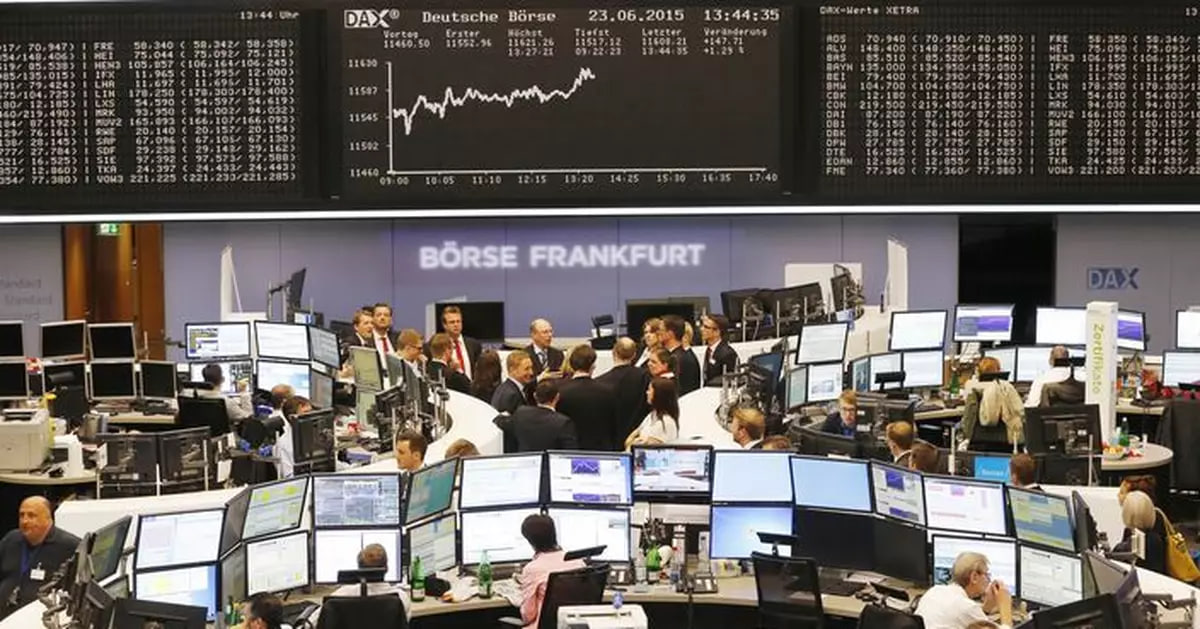Global Market Volatility: Navigating the Ups and Downs of Bitcoin and Stock Markets
Meta Description: Dive into the latest global market fluctuations, analyzing the recent dip in US and European equities, the surge in Bitcoin, and the performance of Chinese stocks. Expert insights and analysis included. Keywords: Global Market Volatility, Bitcoin Price, Stock Market Crash, US Stock Market, European Stock Market, Chinese Stocks, Cryptocurrency, Investment Strategy
Whoa, hold onto your hats, folks! The global financial landscape is a rollercoaster right now, a wild ride of ups and downs that's leaving even seasoned investors scratching their heads. This week alone we've seen a dramatic dip in major stock markets, a surprising resurgence of Bitcoin, and a mixed bag for Chinese stocks. It's a whirlwind of data, analysis, and speculation, and it's enough to make your head spin. But fear not! As a veteran market watcher with years of experience navigating these turbulent waters, I'm here to break down the complexities, provide some much-needed clarity, and help you understand what's happening and, more importantly, what it means for your investments. We'll explore the underlying factors driving these recent market shifts, examine the performance of various asset classes, and offer actionable insights to help you make informed decisions in this dynamic environment. Prepare for a deep dive into the fascinating, sometimes terrifying, world of global finance – buckle up, because it's going to be a bumpy ride! We'll cover everything from the Fed's cautious stance on interest rates to the surprising resilience of Bitcoin and the fascinating performance of Chinese stocks in the face of global uncertainty. Get ready to equip yourself with the knowledge and understanding to navigate this ever-changing financial jungle!
Recent Market Volatility: A Deep Dive
The recent market volatility is a complex issue, not a simple "up" or "down" situation. Several interconnected factors are at play, creating a situation that requires careful consideration. Let's unpack the key drivers:
The Fed's Cautious Approach: The Federal Reserve's (Fed) approach to interest rate adjustments has been a major influence. While a rate cut isn't off the table, the Fed is adopting a wait-and-see approach, carefully evaluating the incoming economic data before making significant decisions. This cautious stance introduces uncertainty, making investors hesitant to make large commitments. This "wait-and-see" game is far from over – and its ongoing impact on investor sentiment is significant. Remember, folks, the Fed isn't just playing checkers; they're playing a high-stakes game of 3D chess involving global economic factors.
Retail Sales Data and its Impact: The recent mixed bag of US retail sales data further complicated the situation. While October's retail sales showed some growth, underlying trends are less clear. This ambiguity leaves economists and investors with more questions than answers, exacerbating the existing uncertainty. It's like trying to read tea leaves – you can see some patterns, but the overall picture remains fuzzy.
Geopolitical Factors: We can't ignore the elephant in the room: Geopolitical events continue to exert pressure on global markets. International tensions, trade disputes, and unexpected global events all contribute to the ongoing uncertainty. It's a complex equation with many unpredictable variables. Think of it like a Jenga tower – one wrong move, and the whole thing could come crashing down.
The Fall of US and European Equities
On Friday, the US markets experienced a significant downturn. The Dow Jones Industrial Average (DJIA) fell by 0.7%, the S&P 500 by 1.32%, and the tech-heavy Nasdaq Composite by a steeper 2.24%. European markets followed suit, with similar declines across major indices. This coordinated decline highlights the interconnected nature of global markets and the impact of shared concerns. It was a domino effect, with one market's weakness triggering a chain reaction across the globe.
Analyzing the Losses: These losses weren’t random; they reflected investor concerns about the aforementioned issues. The Fed's cautious approach, mixed retail sales data, and persistent geopolitical uncertainty all contributed to the sell-off. Investors are seeking safer havens amidst the uncertainty.
The Rise of Bitcoin and Chinese Stocks
Amidst the turmoil in traditional markets, Bitcoin showed remarkable resilience. After a brief dip below $87,000, it bounced back, exceeding $91,000. This demonstrates Bitcoin's growing status as a potential safe haven asset and an alternative investment avenue. It's a testament to its increasing appeal as a hedge against traditional market fluctuations.
Chinese Stocks: A Mixed Bag: Meanwhile, Chinese stocks presented a more complex picture. While the broader A-share market experienced a decline, many US-listed Chinese companies performed well. This divergence highlights the intricate relationship between domestic and international markets and the varied responses to global events. It’s a reminder that one size doesn't fit all when it comes to global investments.
Navigating the Market's Volatility: A Strategic Approach
So, what's an investor to do? The current market scenario demands a strategic and cautious approach. Here's a breakdown of key considerations:
-
Diversification is Key: Spread your investments across various asset classes to mitigate risk. A diversified portfolio can weather market storms more effectively than one heavily concentrated in a single sector or asset class. Don’t put all your eggs in one basket – it's a cliché, but it's absolutely true!
-
Risk Tolerance Assessment: Understand your own risk profile. Are you a risk-averse investor or are you comfortable with higher levels of volatility? Your risk tolerance should guide your investment decisions. Knowing your limits is crucial for making smart investment choices.
-
Long-Term Perspective: Don't panic! Maintain a long-term perspective. Short-term market fluctuations are normal; focus on your long-term investment goals. Rome wasn't built in a day, and neither is a successful investment portfolio.
-
Professional Advice: Consider seeking guidance from a qualified financial advisor. A professional can help you develop a personalized investment strategy tailored to your specific needs and risk tolerance. Sometimes, a second pair of eyes – or a whole team of expert eyes – can make all the difference.
Understanding Bitcoin's Recent Surge
The recent Bitcoin surge is a fascinating development in the cryptocurrency market. Several factors contributed to this price rally:
-
Safe Haven Appeal: Bitcoin's reputation as a hedge against inflation and traditional market volatility is driving demand. Investors are seeking alternatives to traditional assets during times of uncertainty.
-
Institutional Adoption: Increasing adoption by institutional investors is boosting confidence in Bitcoin's long-term viability. This growing institutional interest is a strong indicator of Bitcoin's maturing market position.
-
Technological Advancements: Ongoing developments in the Bitcoin ecosystem, such as the Lightning Network, are enhancing scalability and transaction speeds. These upgrades are steadily improving Bitcoin's overall functionality and usability.
-
Limited Supply: Bitcoin has a finite supply of 21 million coins, making it a scarce asset. This scarcity increases its value as demand grows. It’s the ultimate limited-edition asset – and its value continues to rise with demand.
Frequently Asked Questions (FAQs)
Here are some of the most frequently asked questions about the recent market volatility:
Q1: Should I sell all my stocks?
A1: No, panic selling is rarely a good strategy. A well-diversified portfolio can withstand short-term market fluctuations. Consult with a financial advisor before making any rash decisions.
Q2: Is this the start of a market crash?
A2: It's impossible to predict the future of the market with certainty. The current volatility reflects various factors, but whether it's the prelude to a larger crash remains uncertain.
Q3: What should I do with my Bitcoin holdings?
A3: Bitcoin's price is highly volatile. Your approach should align with your risk tolerance and investment goals. Consult a financial professional for personalized advice.
Q4: Are Chinese stocks a good investment right now?
A4: The performance of Chinese stocks is highly dependent on various factors, both domestic and international. Thorough research and professional advice are essential before investing.
Q5: When will the market stabilize?
A5: Market stabilization depends on various factors, including economic data, geopolitical events, and investor sentiment. No one can predict with certainty when the market will stabilize.
Q6: Is now a good time to buy stocks?
A6: Whether now is a good time to buy depends entirely on your individual circumstances, risk tolerance, and investment strategy. Consult a financial advisor for personalized guidance.
Conclusion
The current global market volatility presents both challenges and opportunities. By understanding the underlying factors driving these fluctuations, adopting a strategic approach, and seeking professional guidance when needed, investors can navigate these turbulent waters and potentially benefit from the market's ups and downs. Remember, informed decisions are crucial in this dynamic environment. Stay updated, stay informed, and stay adaptable. The future of the financial markets is uncertain, but with knowledge and a well-crafted strategy, you can increase your chances of success. This isn't just about numbers on a screen; it's about securing your financial future. So, stay informed, stay diligent, and remember – the market is always evolving.



